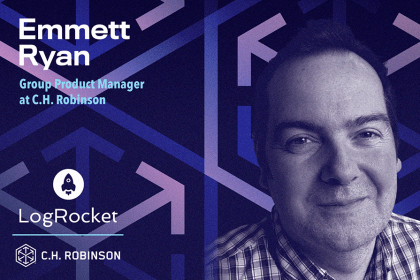Andrew Chen is Chief Product Officer at CommentSold, a live video commerce platform. He began his career in consulting and worked for Hudson River Group and Accenture before transitioning to commerce. Andrew has experience managing product platforms, developing product methodology, and building and launching mobile commerce apps. He has held various product leadership roles at companies such as iHeartMedia, Gilt, BaubleBar, and Flow Commerce.

In our conversation, Andrew talks about how live video is transforming ecommerce opportunities for brands by increasing retention, customer satisfaction, and purchase confidence in consumers. He discusses the importance of authenticity in ecommerce and connecting with audiences, and how CommentSold’s platform enables real brand connections between companies and consumers. Andrew also shares how his team adapts the product based on trends and demographics, including prioritizing mobile-first to best accommodate Gen Z.
Video commerce is the ability of any brand, retailer, shop, or creator — really anyone who wants to sell something online — to engage with their customers through video. It’s an evolving space and we’re excited to be at the forefront of it. We know that both live and passive video is a great way to engage audiences, talk about a product, and allow consumers to see and “feel” the product through the advent of video.
We believe this is the next generation of commerce. More brands are moving away from static product pages where you just see an image. For example, if you go to Amazon’s homepage, you’ll see Amazon Live halfway down the page. We see Walmart pursuing live video as well. Sephora has been utilizing live for customer service among other avenues. Across the board, we see video as a new form of engagement. It brings in higher retention rates, increased customer satisfaction, and more confidence from consumers in their purchases.
When I joined CommentSold, it was like an extension of the QVC era. QVC still exists — the channel is dedicated to talking about products. For a long time, QVC and Home Shopping Network were very popular. Consumers engaged heavily— they saw people talking about products live, would call in, and place and order. It was highly effective because consumers could see the product “in action” as opposed to just reading the description or looking at a picture. When ComentSold was founded, it was similar to QVC for millenials — and now Gen Z.
First, CommentSold, is a full-stack, ecommerce platform, meaning that individual shops will have their own website and mobile apps that we create for them. They also have a backend to manage their inventory, fulfillment, and all the normal ecommerce components.
Secondly, we inherently integrate live selling and video commerce services. A shop can use their own phone as a camera and begin to stream — on their app, website, or even on Instagram — and invite their audience to join. That’s where we help. We bring all of that together into one audience. The company can see all the people signing on, interact with them in chat while they’re talking about products, etc. They can use a scan gun or click on the next product, and the audience will see that on their screen. If someone wants to buy the product, they can add it to their cart and buy it immediately. That’s a feature that we see our shops using every single day.
Yes. Engagement and retention rates are off the charts, and that’s one of the reasons I decided to come to CommentSold. I’ve been in ecommerce for over 15 years, and the standard has always been a 1.5–2 percent conversion rate on a website. Traditionally, someone will come back to shop at a site 1–3 times a year and make a purchase. Companies that utilize live video and shopping see customers come back 2–3 times a week, which is crazy.
I think the differentiator is that people connect with the live video engagement. They’re chatting with the brand and the host, and that keeps people coming back. They say things like, “They’re like me. I get them, and I love the stuff they wear, so I’m going to come back. I’m going to see what they’re selling.” That’s the key here. In everything we talk about, it’s not just selling that is the endpoint — it’s about being able to build a relationship between people from everywhere in a way that is scalable and still meaningful.
We see studies about people doomscrolling on Instagram and TikTok. People aren’t engaging as much — they’re looking at their phones and not having real conversations. It’s having a negative effect across the board. There’s a lot of commentary out there, but from our perspective, we want to bring the aspect of relationship back to this equation.
Traditionally, someone would walk into a store and talk to a sales associate. They might ask about the product, get recommendations, and try things on. That’s the kind of relationship we want to foster, but the question is how to foster that in a fully digital environment. Video commerce is a vehicle to enhance that engagement. What people value is authenticity. This is why big brands sometimes fall flat — they default to a high production budget with a famous host. There is a space for that, but we have shops that make tens of millions of dollars a year just because they’re authentic with their audience.
When these successful shops are in front of their audience and they’re going live, the host has their kids running around, or they may bring their spouse in to make some commentary. People enjoy those relatable experiences. They see real people they have things in common with, as opposed to a highly paid host who is dressed up like a model and showing off fancy items.
We see it in a couple of ways. One, we’ve been working with influencers and creators as a way to partner with our shops. They help them engage with new audiences. We also work with creators who are looking for new avenues of income. This is where one of our products, PopShopLive, comes in. We provide them with a platform to be able to engage in live commerce as a way for them to make a living.
We bring creators on, and they can pick from a whole set of products that we’ve integrated directly from brands and retailers. They can order samples, try them on, and use those in the videos, but at the end of the day, we do the end-to-end service for them. All they have to do is shop the catalog of products, click on the ones they want, and it’s immediately added to their inventory. If someone buys that product, it goes to our fulfillment warehouses, and we ship that for them. If the creator needs to make a return, the return label is automatically generated, they ship it back, and it goes to the warehouse. We created the PopShopLive platform with the creator in mind.
Ecommerce has been around for decades, and there are only so many ways you can optimize a product description page and conversion funnel. There are only so many things you can do with checkout. There’s nothing revolutionary left in just core ecommerce. But video commerce is new, and we are now at the point where technology has accelerated enough to enable live video streaming. We’re allowing mom-and-pop shops with small teams to do the same thing as huge companies. We have an easy-to-use dashboard that allows them to go live, see the status of their video, and engage with the audiences coming in.
We’re able to use AI to identify the most engaging aspects of the videos. These are all new behaviors and user experiences that no one’s ever done before. We go back to first principles and complete blank slates to ask, “How do we imagine making this seamless and easy?” While video commerce is new, the idea of selling a product is not, but there’s a lot of complexity there. So, how do we take all that complexity out of it?
We just hired an EVP of Data and AI, Filip, who’s been doing amazing work. He works with our data and teams to bring on new technologies. Our perspective is that AI and machine learning are enablers for our shop. We don’t want AI to replace a customer service rep or the human element of brands.
The live or video engagements are so critical. So how do we take AI to enhance that interaction? For example, some companies have customer service teams that aren’t based in the US, but they have a US audience. How do we use AI to help improve English grammar from a prompt standpoint and facilitate more fluent conversation? That’s just one example.
We’ve also been building AI video clips with the model imaging into our products. We’re working on things like utilizing AI to understand a brand’s voice and how a company speaks by reviewing the history of its product descriptions. And then, as new products come into the warehouse, how can we help write product descriptions in that same voice with the foundational information that was already provided? That saves the brand time and helps them spend resources building relationships with their customers, which AI cannot do.
Totally. As we think about live shopping, we’ve been looking at modeling from China. There are many variables relating to the advent of how live shopping came about, and one that resonates with me is that it’s bigger in Asia than in the West. In China, for example, there is so much proliferation of counterfeit goods that many Chinese consumers have no idea what they can trust. They’d say, “I want an authentic bag,” but they didn’t know which option was actually real. They had to go to a trusted source — a creator or influencer — called a key opinion leader.
Video became a way of countering the counterfeit. That, among other behaviors, was a critical aspect of why live shopping really grew in China. People were looking to these key opinion leaders as a trusted source. Here in the US, consumers weren’t facing the same issues. We see live as an option in the US and the West, but some of the foundational assumptions aren’t as applicable.
In addition to seeing huge opportunities in live, there’s a lot of potential in the non-live aspect of video commerce. These are things like short-form videos that you can then post and engage. It’s not directly live, but it’s a result of your live. We see that all the time. People are scrolling through Instagram and TikTok in short-form videos. So how do we take that same behavior and apply it to someone’s website? This is what we think about in terms of seeing something in one market and making it applicable to our markets.
Part of the innovation that has enabled a lot of this is mobile. Everyone has access to a high-quality camera, and phones have tons of capabilities. But especially from a generational perspective, Gen Z is behaviorally mobile-first. I even see this in my kids. They’re used to their iPads, and that’s their preferred way of engaging. If I say, “Let’s go to the movie theater and see this movie on a giant screen,” they’re like, “Why do I need a giant screen? I like it on my iPad.” That is what they’re used to.
We have to design from a mobile-first standpoint because of that. We have to make engagement and our capabilities work within a small form factor as opposed to a large form factor. The way we process things has to be straightforward and clear. The technology and infrastructure design has to be mobile capable as well. That’s critical.
You can build something beautiful and easy to use, but the streaming, bit rate, etc., needs to all be perfect. We have creators who don’t have computers — they run their entire influencer operation through their phones. We have to make PopShopLive and our other products manageable easily from a phone. The mobile-first mentality has to come from a product mindset, a design mindset, and a technology mindset.
I love investing in areas where I see opportunity or areas that I know well — whether it’s commerce, AI, or infrastructure. I’m part of several angel networks, and what has been helpful for me is hearing and seeing new opportunities come in. I may only invest in one out of 100 opportunities, but I’ve learned about all 100 of them. That helps me understand the new technologies out there and pain points I might not be thinking about.
Investing, to me, is a multifaceted benefit. I’m not just potentially supporting an entrepreneur and maybe getting a return later, but also learning about what’s happening in the wider market. I’m understanding the trends and innovations occurring. It’s not happening in the newsfeed or in public — these companies are building and trying to understand product-market fit. That helps me see what’s coming down the trend pipeline way before it becomes public knowledge. That’s been really beneficial.
LogRocket identifies friction points in the user experience so you can make informed decisions about product and design changes that must happen to hit your goals.
With LogRocket, you can understand the scope of the issues affecting your product and prioritize the changes that need to be made. LogRocket simplifies workflows by allowing Engineering, Product, UX, and Design teams to work from the same data as you, eliminating any confusion about what needs to be done.
Get your teams on the same page — try LogRocket today.
Want to get sent new PM Leadership Spotlights when they come out?

Emmett Ryan shares how introducing agile processes at C.H. Robinson improved accuracy of project estimations and overall qualitative feedback.

Suvrat Joshi shares the importance of viewing trade-off decisions in product management more like a balance than a compromise.

Great product managers spot change early. Discover how to pivot your product strategy before it’s too late.

Thach Nguyen, Senior Director of Product Management — STEPS at Stewart Title, emphasizes candid moments and human error in the age of AI.